
Shortwave radio is radio transmission using radio frequencies in the shortwave bands (SW). There is no official definition of the band range, but it always includes all of the high frequency band (HF), which extends from 3 to 30 MHz. It lies between the medium frequency band (MF) and the bottom of the VHF band.

Software-defined radio (SDR) is a radio communication system where components that conventionally have been implemented in analog hardware are instead implemented by means of software on a computer or embedded system. While the concept of SDR is not new, the rapidly evolving capabilities of digital electronics render practical many processes which were once only theoretically possible.

A walkie-talkie, more formally known as a handheld transceiver, HT, or handheld radio, is a hand-held, portable, two-way radio transceiver. Its development during the Second World War has been variously credited to Donald Hings, radio engineer Alfred J. Gross, Henryk Magnuski and engineering teams at Motorola. First used for infantry, similar designs were created for field artillery and tank units, and after the war, walkie-talkies spread to public safety and eventually commercial and jobsite work.
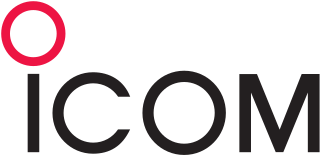
Icom Inc. is a Japanese manufacturer of radio transmitting and receiving equipment, founded in 1954 by Tokuzo Inoue with the company's original name being "Inoue". Its products now include equipment for radio amateurs, pilots, maritime applications, land mobile professional applications, and radio scanner enthusiasts.

Kenwood is a Japanese brand for consumer electronics. Since October 2011, Kenwood has been owned by JVCKenwood as a result of a merger between Kenwood Corporation and JVC. Kenwood manufactures audio equipment such as AM/FM stereo receivers, cassette tape decks/recorders, amateur radio equipment, radios, cellular phones, speakers and other consumer electronics.
The R. L. Drake Company is a manufacturer of electronic communications equipment located in Springboro, Ohio. It is also known for its line of equipment for amateur radio and shortwave listening, built in the 1950s through the 1980s. The company operates as a separate entity owned by Blonder Tongue Laboratories, Inc.

An amateur radio station is a radio station designed to provide radiocommunications in the amateur radio service for an amateur radio operator. Radio amateurs build and operate several types of amateur radio stations, including fixed ground stations, mobile stations, space stations, and temporary field stations. A slang term often used for an amateur station's location is the shack, named after the small enclosures added to the upperworks of naval ships to hold early radio equipment and batteries.

Yaesu FT-101 is a model line of modular amateur radio transceivers, built by the Yaesu Corporation in Japan during the 1970s and 1980s. FT-101 is a set that combines a solid state transmitter, receiver and a tube final amplifier. Its solid state features offer high-performance, low-current characteristics and its tube amplifier provides an almost mismatch-resistant transmitter and tuner stage. FT-101s were made with plug-in circuit boards that could be sent to the dealer or factory for replacement or repair. Until then, modular design was unprecedented in the amateur community. This also explains the fact why so many FT-101s are still in use today. The rig was sold worldwide as Yaesu FT-101 and in Europe as Yaesu FT-101 and as Sommerkamp FT-277. Because of its reliability it earned its nickname "the workhorse".
D-STAR is a digital voice and data protocol specification for amateur radio. The system was developed in the late 1990s by the Japan Amateur Radio League and uses minimum-shift keying in its packet-based standard. There are other digital modes that have been adapted for use by amateurs, but D-STAR was the first that was designed specifically for amateur radio.

The Yaesu FT-817 is one of the smallest MF/HF/VHF/UHF multimode general-coverage amateur radio transceivers. The set is built by the Japanese Vertex Standard Corporation and is sold under the Yaesu brand. With internal battery pack, on board keyer, its all mode/all band capability and flexible antenna, the set is particularly well suited for portable use. The FT-817 is based on a similar circuit architecture as Yaesu's FT-857 and FT-897, so it is a compromise transceiver and incorporates its features to its low price.
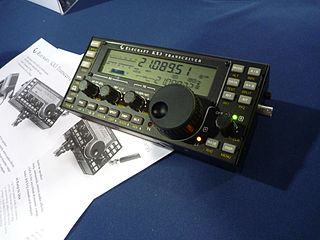
Elecraft, Inc. is an American manufacturer of amateur radio equipment and kits based in Watsonville, California. It was founded in 1998 by Wayne Burdick and Eric Swartz. The company's first product was the K2 transceiver, first prototyped in October 1997.
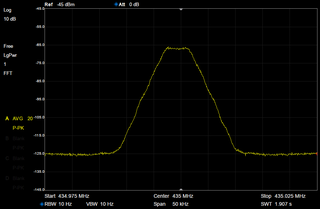
M17 is a digital radio modulation mode developed by Wojciech Kaczmarski et al. M17 is primarily designed for voice communications on the VHF amateur radio bands, and above. The project received a grant from the Amateur Radio Digital Communications in 2021 and 2022. The protocol has been integrated into several hardware and software projects. In 2021, Kaczmarski received the ARRL Technical Innovation Award for developing an open-source digital radio communication protocol, leading to further advancements in amateur radio.
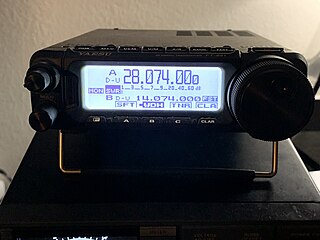
The Yaesu FT-891 is a HF and 6 meters all mode mobile amateur radio transceiver. The FT-891 was first announced to the public by Yaesu at the 2016 Dayton Hamvention. The radio has 100 watts output on CW, SSB, and FM modulations and 25 watts of output in AM. As a mobile transceiver the FT-891 is well suited for mobile installation in vehicles, and weighing less than 5 pounds it is often used for field activations such as Summits On The Air and Parks On The Air. The radio has been praised for its noise reduction and sensitive receiver. Common criticisms of the radio include its many menus that are difficult to navigate with its small screen, the lack of VHF/UHF capabilities, and lack of an internal antenna tuner. Although the radio lacks an internal sound card it still has input and output jacks for audio and be controlled over a USB cable allowing the radio to use digital modes such as WinLink, PSK31 and FT8.

The ICOM IC-7300 is a multimode 6 meter, 4 meter and HF base station amateur radio transceiver. The IC-7300 was announced to the public at the Japan Ham Fair in 2015. The radio has 100 watts output on CW, SSB, and FM modulations and 25 watts of output in AM. Although not the first software-defined radio on the market, the IC-7300 was the first mass-produced mainstream amateur radio to use SDR technology instead of the older PLL-based transceiver design. Designed to replace the older IC-746PRO the IC-7300 is smaller and significantly lighter than its predecessor. Like many other radios of its class the IC-7300 has an internal antenna tuner and contains an internal audio card accessible over USB. This allows the radio to be used for popular digital modes such as PSK31, Winlink, and FT8. The radio has received praise for its easy to use menus, large readable screen, and excellent audio processing.
The ICOM IC-7100 is a multimode HF/VHF/UHF mobile amateur radio transceiver. The IC-7100 has support for a wide variety of commonly used amateur radio modes including ICOMs proprietary digital voice mode DSTAR. Additionally the radio offers 100 watts on HF, 50 watts on VHF, and 35 watts on UHF. The IC-7100 is unique in that it has a large detachable control head with a slanted display so the transmitter can be installed elsewhere in a vehicle or home. The receiver used in the IC-7100 is a triple conversion superheterodyne and has excellent DSP and audio filters. The IC-7100 allows for connection to a computer over USB which enables the radio to be used for popular digital modes such as FT8, Winlink, and Packet Operation. Locations of nearby repeaters and sending APRS locations can be done with an optional GPS receiver attachment. Notable features that the IC-7100 lacks is an internal antenna tuner.
The ICOM IC-905 is a multimode VHF/UHF/SHF portable amateur radio transceiver. The radio has between 10 and 0.5 watts of transmitter output depending on the frequency selected. The radio was announced by ICOM on 22 August 2022 at the Tokyo Ham Radio Fair in Japan. The IC-905 has support for a wide variety of commonly used amateur radio modes including the Japan Amateur Radio League's digital voice mode DSTAR. The form factor of the control head for the IC-905 is similar to that of the IC-705 and includes its large screen and spectrum scope. With the radio unit being remotely controlled from a distance in order to reduce loss over long coax cable runs. This is an important adaptation for this radio system as losses increase with the frequency being used. The IC-905 uses a built in GPS receiver to stabilize its frequency and time base. It has been noted that the IC-905 has a wide range of frequencies but lacks the 222MHz and 902MHz amateur bands as these are only available in North America and not Japan. The unit supports up to four external antennas and has built in support for wired Ethernet, USB Type C and an SD card reader. The addition of a USB connector allows users to connect their computers to the IC-905 for running digital data modes such as PSK31, or FT8, the integration of Ethernet support will be a useful feature for mobile contesters.
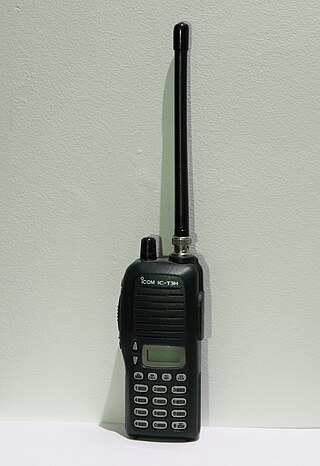
The Icom IC-V82 is a VHF band handheld transceiver designed by Icom for radio amateurs and professionals who require VHF communication. Although it is a little outdated,, the IC-V82 is still valued in the second hand market for a number of additional features such as the ability to convert it, by adding a module, into a digital device, which make it ideal for certain applications requiring voice and/or data encryption.














